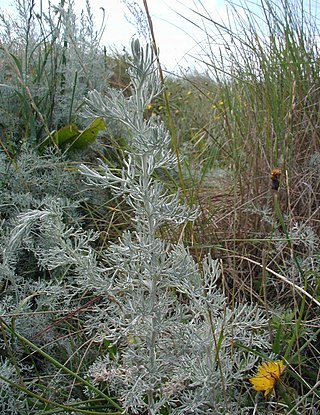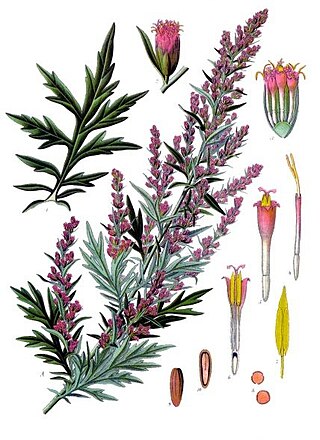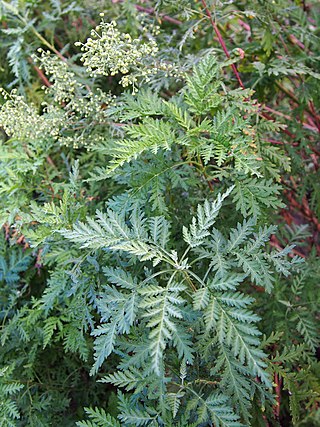
Artemisia is a large, diverse genus of plants belonging to the daisy family Asteraceae, with between 200 and 400 species. Common names for various species in the genus include mugwort, wormwood, and sagebrush.

Artemisia vulgaris, the common mugwort, is a species of flowering plant in the daisy family Asteraceae. It is one of several species in the genus Artemisia commonly known as mugwort, although Artemisia vulgaris is the species most often called mugwort. It is also occasionally known as riverside wormwood, felon herb, chrysanthemum weed, wild wormwood, old Uncle Henry, sailor's tobacco, naughty man, old man, or St. John's plant. Mugworts have been used medicinally and as culinary herbs.

Absente is a brand name of 110 proof anise liqueur that has been marketed under the tagline "Absinthe Refined" since c. 2000. "Absente" is a French word that translates as "absent" in English.

Artemisia absinthium, otherwise known as common wormwood, is a species of Artemisia native to North Africa and temperate regions of Eurasia, and widely naturalized in Canada and the northern United States. It is grown as an ornamental plant and is used as an ingredient in the spirit absinthe and some other alcoholic beverages.

Artemisia maritima is a European species of wormwood known as sea wormwood and old woman. It is native to France, the United Kingdom, Italy, Belgium, Germany, Denmark, Sweden, Bulgaria and Russia.

Artemisia abrotanum, the southernwood, lad's love, or southern wormwood, is a species of flowering plant in the sunflower family. It is native to Eurasia and Africa but naturalized in scattered locations in North America. Other common names include: old man, boy's love, oldman wormwood, lover's plant, appleringie, garderobe, Our Lord's wood, maid's ruin, garden sagebrush, European sage, sitherwood and lemon plant.

Wormwood is a star or angel which appears in the Book of Revelation.

Génépi or génépy is a traditional French herbal liqueur or aperitif popularized in the Alpine regions. Genepi also refers to alpine plants of the genus Artemisia that is used to make a liqueur in the French region of Savoy where the Artemisia genepi plants grow and where the beverage is commonly produced.

Mugwort or biboz is a common name for several species of aromatic flowering plants in the genus Artemisia. In Europe, mugwort most often refers to the species Artemisia vulgaris, or common mugwort. In East Asia the species Artemisia argyi is often called "Chinese mugwort" in the context of traditional Chinese medicine, Ngai Chou in Cantonese or àicǎo (艾草) in Mandarin. Artemisia princeps is a mugwort known in Korea as ssuk (쑥) and in Japan as yomogi (ヨモギ). While other species are sometimes referred to by more specific common names, they may be called simply "mugwort" in many contexts.

Artemisia afra, the African wormwood,[4] is a common species of the genus Artemisia in Africa, with a wide distribution from South Africa, to areas reaching to the North and East, as far north as Ethiopia. Artemisia afra is the only species in this genus indigenous to the African continent.
Artemisia alaskana, the Alaskan sagebrush or Alaskan wormwood or Siberian wormwood, is a North American species of plants in the sunflower family. It is found in British Columbia, the Yukon, the Northwest Territories, and Alaska. Some authors have considered it as a subspecies as the Russian species A. kruhsiana.

Artemisia campestris is a common and widespread species of plants in the sunflower family, Asteraceae. It is native to a wide region of Eurasia and North America. Common names include field wormwood, beach wormwood, northern wormwood, Breckland wormwood, boreal wormwood, Canadian wormwood, field sagewort and field mugwort.

Artemisia biennis is a species of sagebrush known by the common name biennial wormwood. It is a common and widely distributed weed, so well established in many places that its region of origin is difficult to ascertain. This species is most likely native to northwestern North America and naturalized in Western Europe, and eastern and southern North America.

Artemisia cana is a species of sagebrush native to western and central North America; it is a member of the sunflower family. It is known by many common names, including silver sagebrush, sticky sagebrush, silver wormwood, hoary sagebrush, and dwarf sagebrush.

Artemisia stelleriana is an Asian and North American species of plants in the sunflower family. It is native to China, Japan, Korea, Russian Far East, and the Aleutian Islands in the United States. The species is widely cultivated as an ornamental and naturalized in scattered locations in North America, primarily on coastal dunes and other sandy locations, as well as in Scandinavia. Common names include hoary mugwort, Dusty Miller, beach wormwood, and oldwoman.

Artemisia gmelinii, also known as Artemisia sacrorum and Russian wormood, is a shrub in the family Asteraceae. It is native to China, Russia, Japan, and other parts of central Asia. A. gmelinii contains Veratric acid.

Artemisia laciniata is a species of wormwood in the family Asteraceae. Its common name is the Siberian wormwood. It is mostly found in Russia, Alaska, the Yukon, and other parts of the US and Europe.

Artemisia japonica, commonly known as the Japanese wormwood or the Oriental wormwood, is a species of wormwood in the family Asteraceae that is native to Japan, Korea, China, Southeast Asia, and the Indian Subcontinent.

















